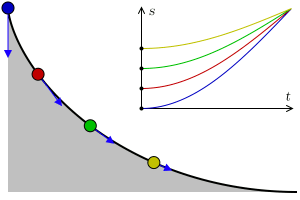"등시강하곡선 문제 (Tautochrone problem)"의 두 판 사이의 차이
(피타고라스님이 이 페이지를 개설하였습니다.) |
Pythagoras0 (토론 | 기여) |
||
| (사용자 2명의 중간 판 53개는 보이지 않습니다) | |||
| 1번째 줄: | 1번째 줄: | ||
| + | ==개요== | ||
| + | * 중력을 받고 있는 물체가 출발점에 관계없이 주어진 목적지에 똑같은 시간에 도달하기 위해서 따라야 하는 곡선 | ||
| + | * [[사이클로이드]]에 의하여 만족됨 | ||
| + | * 1659년 호이겐스에 의해 해결 | ||
| + | * 진자 시계를 만드는데 활용되었다 http://hom.wikidot.com/the-cycloid | ||
| + | |||
| + | |||
| + | |||
| + | |||
| + | |||
| + | ==등시성의 증명== | ||
| + | |||
| + | [[파일:4402517-Tautochrone_curve(1).gif]] | ||
| + | |||
| + | (정리) 사이클로이드를 따라 움직이는 추의 주기는 시작점의 위치에 관계없이 다음으로 주어진다. | ||
| + | :<math>T =2\pi\sqrt{\frac{r}{g}}</math> | ||
| + | |||
| + | (이 때, 사이클로이드의 방정식은 <math>x = r(\theta - \sin \theta)</math>, <math>y = -r(1 - \cos \theta)</math>로 주어졌다고 하자.) | ||
| + | |||
| + | (증명) | ||
| + | |||
| + | 출발점의 y좌표를 <math>y=y_0</math>라 두고, 그 때 곡선의 파라메터를 <math>\theta=\theta_0</math>라 하자. | ||
| + | |||
| + | 움직이는 추의 속도는 <math>v=\sqrt{2g(y_0-y)}= \sqrt{2rg(\cos\theta_0-\cos\theta)}</math> 로 주어진다. 따라서 주기를 다음과 같이 쓸 수 있다 | ||
| + | :<math>T =\int \frac{ds}{v}=2\int_{\theta_0}^{\pi} \frac{\sqrt{2r^2(1-\cos\theta)}}{\sqrt{2rg(\cos\theta_0-\cos\theta)}}\,d\theta=2\sqrt{\frac{r}{g}}\int_{\theta_0}^{\pi} \frac{\sqrt{1-\cos\theta}}{\sqrt{\cos\theta_0-\cos\theta}}\,d\theta \label{vel}</math> | ||
| + | |||
| + | 반각공식을 이용하여, \ref{vel}의 우변을 다음과 같이 쓸 수 있다 | ||
| + | |||
| + | :<math>2\sqrt{\frac{r}{g}}\int_{\theta_0}^{\pi}\frac{\sin(\frac{1}{2}\theta)}{\sqrt{\cos^2(\frac{1}{2}\theta_0)-\cos^2(\frac{1}{2}\theta)}}d\theta </math> | ||
| + | 여기서 | ||
| + | :<math>u=\frac{\cos \frac{1}{2}\theta}{\cos \frac{1}{2}\theta_0}</math>로 치환하면, | ||
| + | :<math>du=\frac{-\sin \frac{1}{2}\theta}{2\cos \frac{1}{2}\theta_0}\,d\theta</math> 를 얻는다. | ||
| + | |||
| + | 따라서 | ||
| + | :<math>T =4\sqrt{\frac{r}{g}}\int_{0}^{1} \frac{1}{\sqrt{1-u^2}}\,du=2\pi\sqrt{\frac{r}{g}}</math>■ | ||
| + | |||
| + | |||
| + | |||
| + | |||
| + | ==관련동영상== | ||
| + | * 1분 15초 부터 | ||
| + | * http://www.youtube.com/watch?v=FAYWccuLVvY#t=1m15s | ||
| + | |||
| + | |||
| + | |||
| + | ==메모== | ||
| + | * http://www.baropage.com/file_board/view.php?id=life02&page=1&sn1=&divpage=1&sn=off&ss=on&sc=on&select_arrange=hit&desc=desc&no=95 | ||
| + | |||
| + | |||
| + | |||
| + | |||
| + | ==메모== | ||
| + | |||
| + | * [http://www.math.nmsu.edu/%7Ehistory/mm-3-2-huygens.pdf http://www.math.nmsu.edu/~history/mm-3-2-huygens.pdf] | ||
| + | * [http://lilith.gotdns.org/%7Evictor/writings/0033huygens.pdf Christiaan Huygens and the Scientific Revolution] | ||
| + | |||
| + | |||
| + | |||
| + | |||
| + | |||
| + | ==관련된 항목들== | ||
| + | * [[사이클로이드]] | ||
| + | * [[단진자의 주기와 타원적분]] | ||
| + | |||
| + | |||
| + | ==매스매티카 파일 및 계산 리소스== | ||
| + | * https://docs.google.com/file/d/0B8XXo8Tve1cxUGZ6TlpTemFuazg/edit | ||
| + | |||
| + | |||
| + | |||
| + | ==수학용어번역== | ||
| + | |||
| + | * Tautochrone problem | ||
| + | ** 등시강하곡선 문제 | ||
| + | |||
| + | |||
| + | |||
| + | |||
| + | ==사전 형태의 자료== | ||
| + | * http://en.wikipedia.org/wiki/Tautochrone_problem | ||
| + | * http://mathworld.wolfram.com/TautochroneProblem.html | ||
| + | |||
| + | |||
| + | |||
| + | |||
| + | ==관련논문== | ||
| + | |||
| + | * [http://www.jstor.org/stable/2695647 The Cycloidal Pendulum] | ||
| + | ** Jeff Brooks and Satha Push, The American Mathematical Monthly Vol. 109, No. 5 (May, 2002), pp. 463-465 | ||
| + | |||
| + | |||
| + | [[분류:곡선]] | ||
| + | |||
| + | ==메타데이터== | ||
| + | ===위키데이터=== | ||
| + | * ID : [https://www.wikidata.org/wiki/Q3284444 Q3284444] | ||
| + | ===Spacy 패턴 목록=== | ||
| + | * [{'LOWER': 'tautochrone'}, {'LEMMA': 'curve'}] | ||
| + | * [{'LOWER': 'isochrone'}, {'LEMMA': 'curve'}] | ||
2021년 2월 17일 (수) 05:03 기준 최신판
개요
- 중력을 받고 있는 물체가 출발점에 관계없이 주어진 목적지에 똑같은 시간에 도달하기 위해서 따라야 하는 곡선
- 사이클로이드에 의하여 만족됨
- 1659년 호이겐스에 의해 해결
- 진자 시계를 만드는데 활용되었다 http://hom.wikidot.com/the-cycloid
등시성의 증명
(정리) 사이클로이드를 따라 움직이는 추의 주기는 시작점의 위치에 관계없이 다음으로 주어진다. \[T =2\pi\sqrt{\frac{r}{g}}\]
(이 때, 사이클로이드의 방정식은 \(x = r(\theta - \sin \theta)\), \(y = -r(1 - \cos \theta)\)로 주어졌다고 하자.)
(증명)
출발점의 y좌표를 \(y=y_0\)라 두고, 그 때 곡선의 파라메터를 \(\theta=\theta_0\)라 하자.
움직이는 추의 속도는 \(v=\sqrt{2g(y_0-y)}= \sqrt{2rg(\cos\theta_0-\cos\theta)}\) 로 주어진다. 따라서 주기를 다음과 같이 쓸 수 있다 \[T =\int \frac{ds}{v}=2\int_{\theta_0}^{\pi} \frac{\sqrt{2r^2(1-\cos\theta)}}{\sqrt{2rg(\cos\theta_0-\cos\theta)}}\,d\theta=2\sqrt{\frac{r}{g}}\int_{\theta_0}^{\pi} \frac{\sqrt{1-\cos\theta}}{\sqrt{\cos\theta_0-\cos\theta}}\,d\theta \label{vel}\]
반각공식을 이용하여, \ref{vel}의 우변을 다음과 같이 쓸 수 있다
\[2\sqrt{\frac{r}{g}}\int_{\theta_0}^{\pi}\frac{\sin(\frac{1}{2}\theta)}{\sqrt{\cos^2(\frac{1}{2}\theta_0)-\cos^2(\frac{1}{2}\theta)}}d\theta \] 여기서 \[u=\frac{\cos \frac{1}{2}\theta}{\cos \frac{1}{2}\theta_0}\]로 치환하면, \[du=\frac{-\sin \frac{1}{2}\theta}{2\cos \frac{1}{2}\theta_0}\,d\theta\] 를 얻는다.
따라서 \[T =4\sqrt{\frac{r}{g}}\int_{0}^{1} \frac{1}{\sqrt{1-u^2}}\,du=2\pi\sqrt{\frac{r}{g}}\]■
관련동영상
메모
메모
- http://www.math.nmsu.edu/~history/mm-3-2-huygens.pdf
- Christiaan Huygens and the Scientific Revolution
관련된 항목들
매스매티카 파일 및 계산 리소스
수학용어번역
- Tautochrone problem
- 등시강하곡선 문제
사전 형태의 자료
- http://en.wikipedia.org/wiki/Tautochrone_problem
- http://mathworld.wolfram.com/TautochroneProblem.html
관련논문
- The Cycloidal Pendulum
- Jeff Brooks and Satha Push, The American Mathematical Monthly Vol. 109, No. 5 (May, 2002), pp. 463-465
메타데이터
위키데이터
- ID : Q3284444
Spacy 패턴 목록
- [{'LOWER': 'tautochrone'}, {'LEMMA': 'curve'}]
- [{'LOWER': 'isochrone'}, {'LEMMA': 'curve'}]
